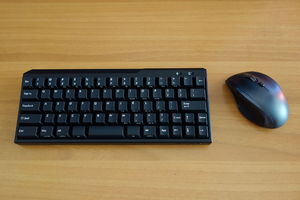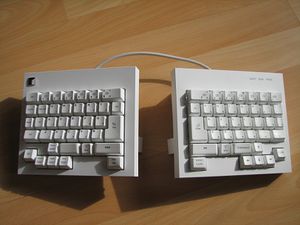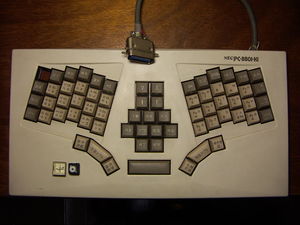Staggering
| This article requires illustration in the form of diagrams — A diagram per stagger would convey the meaning and facilitate recognition faster than any amount of text. Also, a simple diagram that is readable at first glance and conveniently placed at the beginning of the article would improve usability, see Keyboard profile for an example. |
In keyboarding parlance, staggering refers to the rows or columns of a keyboard being set offset to one-another.
Contents
Classic typewriter keyboard
The classic QWERTY typewriter keyboard layout has offsets between key rows, and the offsets are not the same. Thus, it is double staggered. The offsets are 1/2 key, 1/4 key and 1/2 key respectively.
The reason for this staggering was to allow equal distance between the arms that connect the keys to the type-writing mechanism. From left to right, as one ascends the keyboard, the keys have positions 1, 3, 2, 4. It is evident from the mechanical arms that each row of keys must have a separate offset, but it is not immediately evident why the offset is 1/2 between the bottom row and the next row up. A more obvious implementation would be 1, 2, 3, 4 (i.e. offsets of 1/4 key all the way up). There must be a reason for this, and it turns out there is.
If one looks at a mechanical typewriter from the side, one sees that the key arms lie in the same plane, but that each row of keys is higher than the one below it. This is done by having the key arm shaped like an L at the end, with different riser heights for different rows. For the upper two rows, when the key is depressed, the riser height is greater than the distance the key is depressed, and so the key does not impact the other key arms. However, the bottom row has almost no riser, and the second row from the bottom has a fairly short riser. The riser for the second row from the bottom is short enough that when those keys are depressed, they nestle in between the key arms for the bottom row. Because the keys in the second row from the bottom are halfway between the keys for the bottom row, the key can be depressed into the space between the bottom row arms without hitting them. Once the bottom and second rows have positions 1 and 3, it is evident that the top two rows will take positions 2 and 4 (or optionally 4 and 2 - at this point there is no design constraint), thus leading to the offsets we typically see. If a constant stagger offset were implemented, then the entire mechanism would have to be taller in order to increase all of the riser heights so that the second row could have a enough riser height to avoid the bottom row key arms. Thus mechanical design considerations from a century ago continue to dictate the keyboard layout used in the 21st century!
There are also computer keyboards with an equal offset of 1/2 key. These days, most keyboards with this layout are point-of-sale keyboards. Vintage keyboards from the Eastern Europe often had this layout, as did several keyboards from Commodore, including the Commodore 128.
The staggers
Here are simplified versions of the various keyboard staggers. The last one is called matrix, ortholinear or orthogonal stagger, although it does not have any stagger at all.
Uniform stagger

A uniform stagger or equal stagger has all letter-rows shifted an equal offset to one-another.
A 1/4-key uniform stagger is more often found among compact keyboards. A 1/2-key uniform stagger is more common among vintage/low-cost and point-of-sale keyboards.
Symmetric stagger

A symmetric stagger is a row-oriented layout organised into a left and a right half, for the left and the right hand respectively. On each half, the row offsets are the same and opposite of the other half.
Columnar layout

Many ergonomic keyboards have instead keys organised in a columnar layout, with the columns shifted at different offsets to better suit the different fingers.
Columnar layouts are sometimes called column-staggered
Matrix layout

A keyboard layout with no staggering is called matrix layout or ortho-linear (or ortholinear) layout. The term "ortho-linear" was supposedly coined in an evaluation study of the TypeMatrix where it is clarified as meaning "matrix".[1]
Matrix layouts are believed by some to help with RSI symptoms but no research can be found on this subject.[2]
References
- ↑ BEST Associates — An Evaluation of the TypeMatrix™ Ergonomic Keyboard. Oldest copy on archive.org is from 2004-01-01. Oldest link to document is on archive.org is from 2003-08-16
- ↑ OLKB.com — OLKB Primer (Wayback Machine) Archived 2018-11-17.

